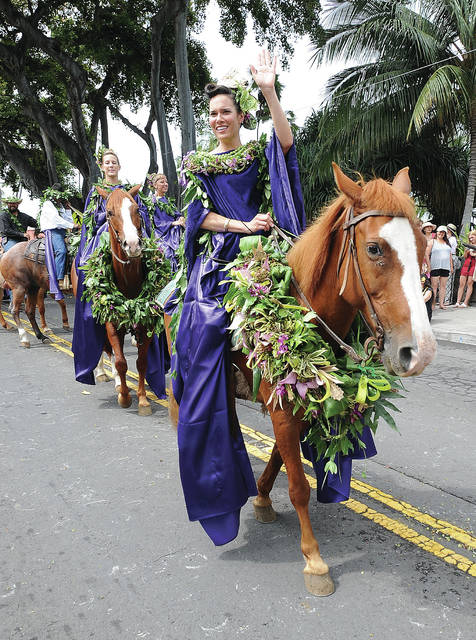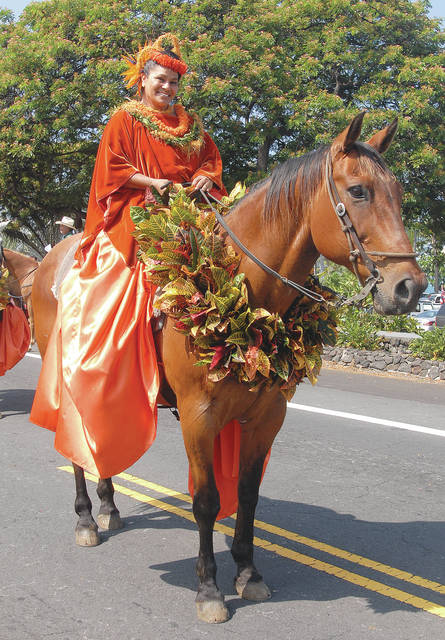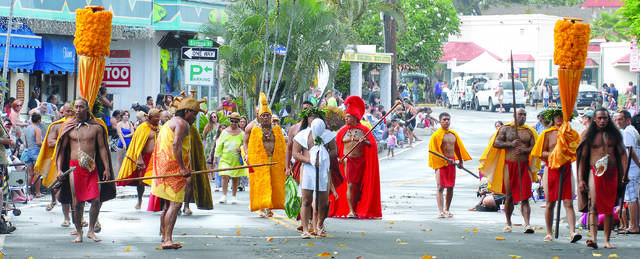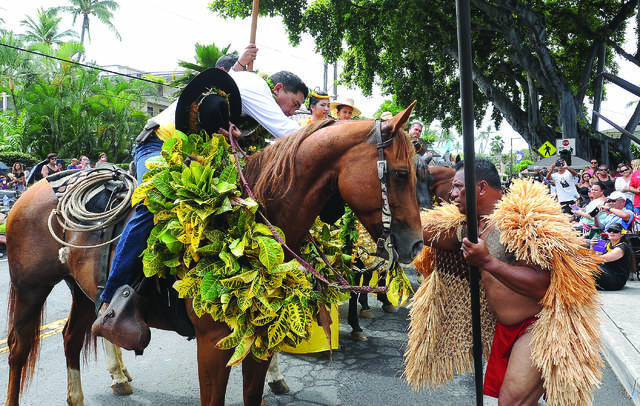Pa’u queen, princesses present long-standing tradition at King Kamehameha Day parade





KAILUA-KONA — An established tradition of the annual King Kamehameha Day Celebration Parade, the equestrian units march down Alii Drive every year displaying their intricate and colorful pa’u and lei that they’ve spent weeks making.
KAILUA-KONA — An established tradition of the annual King Kamehameha Day Celebration Parade, the equestrian units march down Alii Drive every year displaying their intricate and colorful pa’u and lei that they’ve spent weeks making.
The pa’u riding units are made up of princesses representing each of the eight Hawaiian islands, and the pa’u queen, who represents all of Hawaii.
Manu Powers will be riding in the parade as princess of Niihau. This is her second year representing an island in the parade; last year she rode as princess of Kauai. Despite attending the parade as a spectator for years, Powers said she didn’t realize the amount of work that the pa’u riders do for the parade until she became a participant.
“The art of wrapping itself, it looks effortless when they’re sitting up there on the horse,” Powers said. “But we’ve been preparing for weeks, and we’re going to be working every single day until parade day. So although it may look perfect, it actually represents many man-hours to make that and to put that together.”
A type of culotte or skirt, the pa’u is made of a single piece of large fabric wrapped around the rider to flow over the legs and stirrups. The skirt is held in place with kukui nuts that are twisted inside the fabric and tucked inside the waistband.
The lei worn by the horses and their riders are also put together by the pa’u unit. Each island is represented by a different colored flower native to that island. Powers said that the gathering of the flowers has been happening all over the island, and now that the week of the parade is here, the lei making can begin.
“We’ve been gathering and picking, and then you start weeding that out and finding the stuff you can work with, and then you start bunching and assembling,” Powers said. “We’ve been doing this for days the past couple of weeks, and we haven’t even physically started making the leis. We’re just in the process of getting the components together at this point. Over the next three, four days, we’ll start actually physically making the leis. Ultimately, it’s hundred and hundreds of hours that goes into each unit, and each island presentation.”
The tradition of pa’u began in the 1800s following the arrival of the first horses to the Hawaiian islands in 1803. The pa’u was originally designed to protect the clothes worn by a rider while on a horse. The earliest pa’u were fashioned from fabrics of the day, like calico. The arrival of floral parades in the early 1900s saw pa’u skirts transition to satin.
“It’s a very nuanced and specific part of the culture,” Powers said. “It’s not just the art of wrapping, it’s the pa’u itself, the garment. It seems to be an art that’s dying quite rapidly. My personal feeling on the matter is that if I can perpetuate even one component of the culture, then I’m contributing in some way.”
Powers said she hopes exposing the pa’u tradition to those in attendance at the parade will help save the art.
After representing all the islands at the parade, a princess can then become the pa’u queen.
This year’s queen is Ruby Ahlo-Ruiz, a lifetime Kailua-Kona resident. She said after eight years of riding in the parade as a princess, being able to represent all of Hawaii as the queen is a great honor.
“They want to see the queen, because she’s going to represent all the islands and all the hard work she’s done in the past. So, it’s an honor to be riding as the queen,” Ahlo-Ruiz said. “I’m putting my honor in Pele, for what she’s doing right now. She’s destructing and reconstructing. And that’s what we do, we destruct and we reconstruct. We take flowers from the land and we put it back together to make it even more beautiful.
I’m giving back to my island, to all the people, hoping that all the people can understand why we portray this image for our island and why is it so important to us.”
Ahlo-Ruiz said having the pa’u riders and the parade is important to keep the tradition and history of Hawaiian culture alive.
“The tradition of the parade is being able to honor our king, and I’m an ancestor of him, and being able to portray what our island has given to us to share with everyone,” Ahlo-Ruiz said. “We are here to share what Hawaii is about. We’re about love, we’re about sharing and we’re about knowledge and I’ve come into the opportunity to do that. And although I’ve done that throughout my life, this is an honor to be able to show people that and be the highlight of what the King Kamehameha parade means.”
The parade, to be held Saturday in Kailua-Kona, honors King Kamehameha I, who established the first capital of the united Hawaiian kingdom in Kailua-Kona.
The parade begins at 9 a.m. at Old Kona Airport Park, and will travel down Kuakini Highway to Palani Road, where it will then head south down Alii Drive. The parade will pass by Hulihee Palace and other historical landmarks on its way through town to Walua Road near the Royal Kona Resort.
The royal court leads the way of the parade, followed by the Royal Order of Kamehameha, the Queen Kaahumanu Society and then the pa’u queen and grand marshal. This years grand marshal is Alex Ako, a multi-generational Hawaii Island resident.
“Ultimately, it’s an hour and a half on that horse going down Alii Drive, and it’s almost like a wedding, where there’s so much work put into one small, encapsulated moment,” Powers said. “I didn’t know what to expect last year, and I was overwhelmed by the process. This year, knowing what to expect and having a better idea of how the whole thing works, I am just honestly looking forward to being on the horse and going down Alii Drive in all that splendor, and, hopefully, just being able to be present and enjoy the moment.
“It’s quite a spectacle. It’s really something to see.”


